-
 Bitcoin
Bitcoin $83,080.8873
-1.14% -
 Ethereum
Ethereum $1,791.4746
-1.45% -
 Tether USDt
Tether USDt $0.9998
0.02% -
 XRP
XRP $2.1324
-0.13% -
 BNB
BNB $592.0388
-1.08% -
 Solana
Solana $119.1957
-3.22% -
 USDC
USDC $1.0001
0.01% -
 Dogecoin
Dogecoin $0.1681
-1.64% -
 Cardano
Cardano $0.6497
-1.94% -
 TRON
TRON $0.2375
-0.61% -
 UNUS SED LEO
UNUS SED LEO $9.0588
-4.96% -
 Chainlink
Chainlink $12.6860
-2.48% -
 Toncoin
Toncoin $3.2620
-3.95% -
 Stellar
Stellar $0.2511
-3.60% -
 Avalanche
Avalanche $17.8165
-2.01% -
 Shiba Inu
Shiba Inu $0.0...01230
-0.03% -
 Sui
Sui $2.2118
-2.95% -
 Hedera
Hedera $0.1616
-2.22% -
 Litecoin
Litecoin $82.0450
-2.73% -
 Polkadot
Polkadot $3.9414
-2.77% -
 MANTRA
MANTRA $6.2727
-0.36% -
 Bitcoin Cash
Bitcoin Cash $300.4768
-0.31% -
 Dai
Dai $1.0001
0.02% -
 Bitget Token
Bitget Token $4.4469
-1.89% -
 Ethena USDe
Ethena USDe $0.9991
0.00% -
 Pi
Pi $0.5875
11.07% -
 Hyperliquid
Hyperliquid $11.8527
-4.06% -
 Monero
Monero $214.0698
-0.86% -
 Uniswap
Uniswap $5.8104
-2.14% -
 OKB
OKB $51.8157
5.85%
From Hardware to Software: A Complete Analysis of GPU Mining
GPU mining involves choosing the right hardware and software, considering factors like hash rate, power consumption, and algorithm compatibility for optimal profitability.
Mar 31, 2025 at 04:43 am
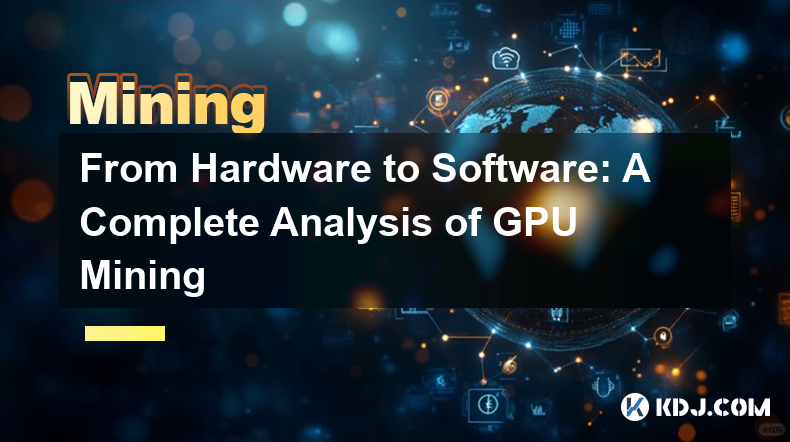
Understanding GPU Mining Hardware
GPU mining, utilizing Graphics Processing Units, is a popular method for mining certain cryptocurrencies, particularly those using algorithms like Ethash (formerly used by Ethereum) and Equihash. The core of GPU mining lies in its hardware. Choosing the right GPU is crucial for profitability. Factors to consider include the GPU's hash rate (measured in hashes per second or H/s), power consumption, memory capacity (VRAM), and price. Higher hash rates generally translate to more mined cryptocurrency, but higher power consumption can offset potential profits.
The selection process often involves comparing different GPU models from manufacturers like NVIDIA and AMD. NVIDIA's RTX and GeForce series, and AMD's Radeon series, are commonly used. However, the optimal choice depends on the specific cryptocurrency being mined and the current market conditions. Always research the best performing cards for your target algorithm. Overclocking, carefully increasing the GPU's clock speed, can boost hash rates but also increases power consumption and risk of damage.
Beyond the GPU itself, a successful mining operation requires other hardware components. A stable and reliable power supply is essential, capable of handling the high power demands of multiple GPUs. A motherboard with enough PCI-e slots is needed to accommodate multiple GPUs. Sufficient RAM and a fast processor are also important, though less critical than the GPU itself. Cooling is paramount; GPUs generate significant heat, requiring adequate fans and potentially custom cooling solutions. Finally, a stable internet connection is necessary for communication with the mining pool.
Software and its Role in GPU Mining
While the hardware forms the foundation, the software is equally crucial for effective GPU mining. Mining software acts as the intermediary, translating the complex mathematical calculations required for mining into instructions that the GPU can understand. Popular mining software options include NiceHash Miner, TeamRedMiner, and PhoenixMiner. Each has its strengths and weaknesses, often tailored to specific algorithms or GPU architectures.
Choosing the right software depends on several factors. Compatibility with your specific GPU model and the algorithm being mined is paramount. The software's efficiency, measured in terms of hash rate per watt, is also a key consideration. Some miners offer advanced features like overclocking controls and monitoring tools, while others prioritize simplicity and ease of use.
The software also facilitates connection to mining pools. Mining pools aggregate the computing power of many miners, increasing the chances of successfully mining a block and earning rewards. Pools operate on a payout system, distributing rewards based on the contribution of each miner to the pool's overall hash rate. Selecting a reputable and reliable mining pool is crucial for ensuring timely and fair payouts. Factors to consider include pool fees, payout methods, and the pool's overall hash rate.
Setting up Your GPU Mining Rig: A Step-by-Step Guide
Setting up a GPU mining rig involves several steps:
- Acquire necessary hardware: This includes GPUs, motherboard, power supply, RAM, CPU, case, and other peripherals.
- Assemble the hardware: Carefully install all components into the computer case, ensuring proper connections and cooling.
- Install the operating system: Choose a suitable operating system, often a lightweight Linux distribution optimized for mining.
- Install mining software: Download and install the chosen mining software, configuring it according to the GPU and algorithm.
- Configure mining pool settings: Input the necessary details for connecting to the chosen mining pool, including the pool address and your wallet address.
- Monitor your rig: Regularly monitor the GPU temperatures, hash rates, and power consumption to ensure optimal performance and prevent overheating.
Optimizing GPU Mining Performance
Optimizing your mining rig for maximum efficiency involves several strategies. Overclocking, as mentioned earlier, can increase hash rates but requires careful monitoring to prevent damage. Proper cooling is critical to maintain stable operation and prevent overheating. This might involve using additional fans, liquid cooling systems, or optimizing case airflow.
Power consumption is another critical factor. Reducing power consumption without significantly impacting hash rate can significantly improve profitability. This can be achieved through undervolting, carefully reducing the voltage supplied to the GPU. Software updates are also important, as developers frequently release updates that improve efficiency and stability. Keeping your software up-to-date ensures you're benefiting from the latest performance enhancements.
Understanding Mining Algorithms and their Impact on GPU Selection
Different cryptocurrencies utilize different mining algorithms. These algorithms determine the type of computational problem that miners need to solve. The choice of GPU is heavily influenced by the algorithm. Some GPUs are better suited to specific algorithms than others. Researching the algorithm used by the cryptocurrency you intend to mine is crucial for selecting the right GPU. For example, Ethash (previously used by Ethereum) favored GPUs with large amounts of VRAM, while Equihash often favored GPUs with high core clocks.
Understanding the algorithm's complexity and its demands on GPU resources is essential for optimizing your mining setup and maximizing profitability. The algorithm's evolution can also impact GPU choices. Algorithm changes can render certain GPUs less efficient, necessitating a reassessment of your hardware strategy. Staying updated on algorithm developments is crucial for maintaining profitability.
Frequently Asked Questions
Q: What is the most profitable GPU for mining?
A: There's no single "most profitable" GPU. Profitability depends on several factors including the cryptocurrency being mined, the mining algorithm, electricity costs, and the current market price of the cryptocurrency. Research current benchmarks and profitability calculators to make an informed decision.
Q: How much can I earn mining cryptocurrency with a GPU?
A: Earnings vary significantly based on factors like the hash rate of your GPU, the cryptocurrency being mined, electricity costs, and the difficulty of the mining algorithm. Profitability calculators can provide estimates, but actual earnings may differ.
Q: Is GPU mining still profitable?
A: The profitability of GPU mining fluctuates based on several factors, including cryptocurrency prices, mining difficulty, and electricity costs. It's crucial to perform thorough research and calculations before investing in GPU mining.
Q: What are the risks associated with GPU mining?
A: Risks include the volatility of cryptocurrency prices, the potential for hardware failure, high electricity costs, and the increasing difficulty of mining certain cryptocurrencies.
Q: What are some alternative mining methods besides GPU mining?
A: Other methods include ASIC mining (Application-Specific Integrated Circuits) which are specialized hardware for mining specific cryptocurrencies, and cloud mining which involves renting computing power from a third-party provider.
Disclaimer:info@kdj.com
The information provided is not trading advice. kdj.com does not assume any responsibility for any investments made based on the information provided in this article. Cryptocurrencies are highly volatile and it is highly recommended that you invest with caution after thorough research!
If you believe that the content used on this website infringes your copyright, please contact us immediately (info@kdj.com) and we will delete it promptly.
- The US Government's Strategic Crypto Reserve Will Be Unveiled This Saturday
- 2025-04-06 05:40:12
- Fartcoin (FAR) price soared 32% to trade at $0.5155
- 2025-04-06 05:40:12
- If Shiba Inu Doubles the Market Cap of Dogecoin, It Could Move Close to Surpassing Its Previous All-Time High (ATH)
- 2025-04-06 05:35:12
- USDtb Breaks into the Top 10 Stablecoins by Market Cap, Tether Loses 60% of Market Dominance
- 2025-04-06 05:35:12
- Meme Coin Mayhem: Markets Stagger, But Troller Cat Roars Ahead
- 2025-04-06 05:30:12
- I'm known for my optimism. I try to give people something to build, not just something to worry about.
- 2025-04-06 05:30:12
Related knowledge
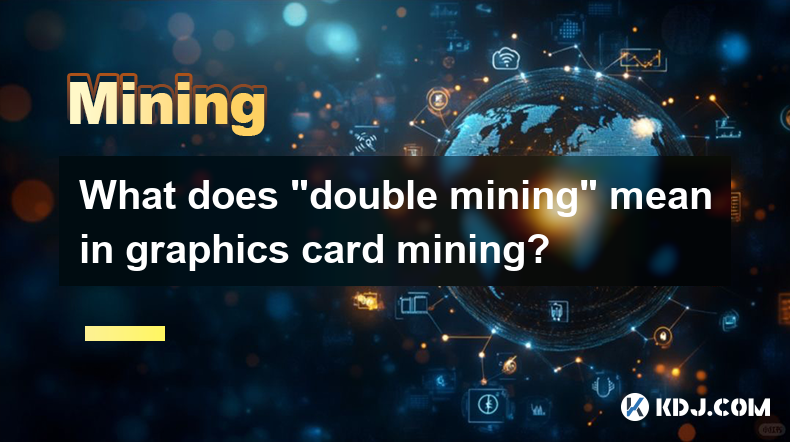
What does "double mining" mean in graphics card mining?
Apr 04,2025 at 08:35pm
In the world of cryptocurrency, the term 'double mining' refers to a specific technique used in graphics card mining to maximize the efficiency and profitability of mining operations. This method involves simultaneously mining two different cryptocurrencies using the same graphics card. The concept of double mining has gained popularity among miners who...
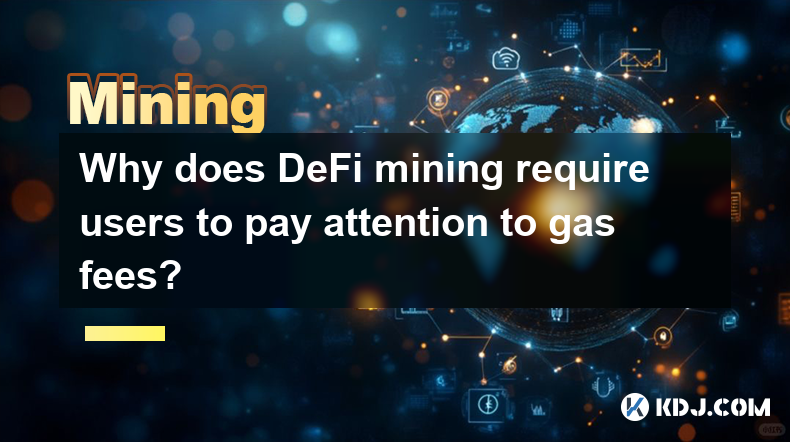
Why does DeFi mining require users to pay attention to gas fees?
Apr 05,2025 at 10:28am
DeFi mining has become a popular way for users to earn passive income in the cryptocurrency space. However, one aspect that users must pay close attention to is gas fees. Gas fees are transaction fees on the Ethereum network, and they play a crucial role in the DeFi mining process. Understanding why gas fees are important and how they affect DeFi mining...

What is the market prospect of CPU mining currency?
Apr 04,2025 at 09:14am
The concept of CPU mining currency has gained traction in the cryptocurrency community due to its accessibility and potential for decentralization. Unlike GPU or ASIC mining, which often requires significant investment in specialized hardware, CPU mining can be performed using standard computer processors. This makes it an attractive option for individu...
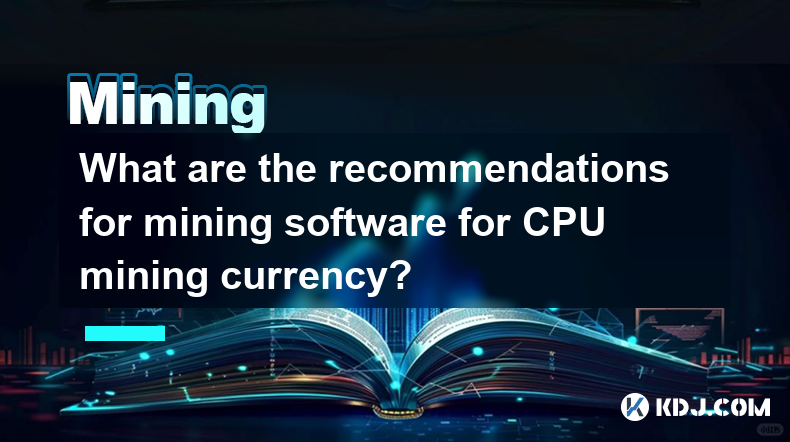
What are the recommendations for mining software for CPU mining currency?
Apr 05,2025 at 05:49pm
CPU mining, while less efficient than GPU or ASIC mining, can still be a viable option for mining certain cryptocurrencies. This article will explore the best software options available for CPU mining, providing detailed recommendations and insights into their features and performance. Understanding CPU MiningCPU mining involves using a computer's centr...
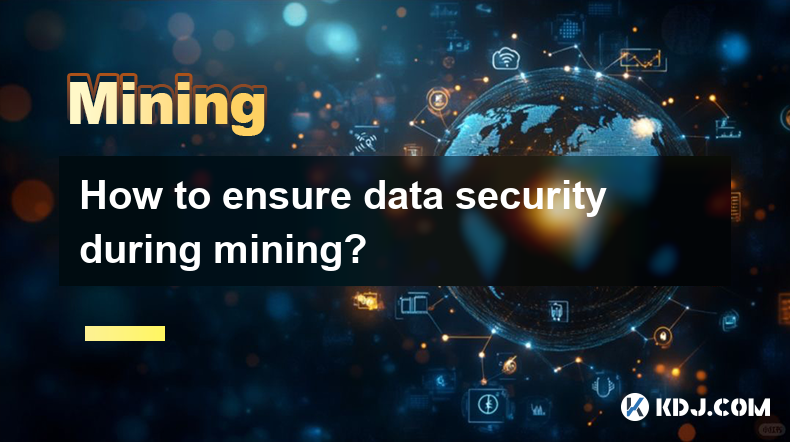
How to ensure data security during mining?
Apr 05,2025 at 08:28am
Ensuring data security during mining is crucial, as miners handle sensitive information and perform transactions that need to be protected against unauthorized access and cyber threats. This article will delve into various strategies and best practices to secure data during the mining process, focusing on the cryptocurrency sphere. Understanding the Ris...
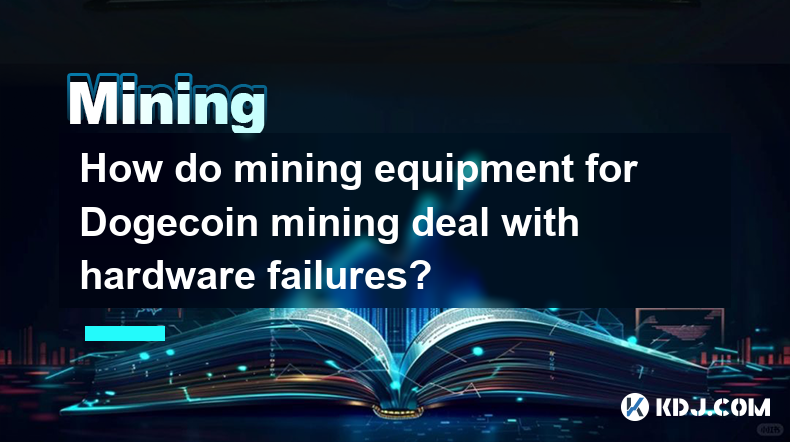
How do mining equipment for Dogecoin mining deal with hardware failures?
Apr 03,2025 at 09:15am
Dogecoin mining, like other forms of cryptocurrency mining, relies heavily on specialized hardware to perform the necessary computations to mine new coins. However, as with any technology, mining equipment can encounter hardware failures. This article will explore how mining equipment for Dogecoin mining deals with such failures, covering various aspect...

What does "double mining" mean in graphics card mining?
Apr 04,2025 at 08:35pm
In the world of cryptocurrency, the term 'double mining' refers to a specific technique used in graphics card mining to maximize the efficiency and profitability of mining operations. This method involves simultaneously mining two different cryptocurrencies using the same graphics card. The concept of double mining has gained popularity among miners who...

Why does DeFi mining require users to pay attention to gas fees?
Apr 05,2025 at 10:28am
DeFi mining has become a popular way for users to earn passive income in the cryptocurrency space. However, one aspect that users must pay close attention to is gas fees. Gas fees are transaction fees on the Ethereum network, and they play a crucial role in the DeFi mining process. Understanding why gas fees are important and how they affect DeFi mining...

What is the market prospect of CPU mining currency?
Apr 04,2025 at 09:14am
The concept of CPU mining currency has gained traction in the cryptocurrency community due to its accessibility and potential for decentralization. Unlike GPU or ASIC mining, which often requires significant investment in specialized hardware, CPU mining can be performed using standard computer processors. This makes it an attractive option for individu...

What are the recommendations for mining software for CPU mining currency?
Apr 05,2025 at 05:49pm
CPU mining, while less efficient than GPU or ASIC mining, can still be a viable option for mining certain cryptocurrencies. This article will explore the best software options available for CPU mining, providing detailed recommendations and insights into their features and performance. Understanding CPU MiningCPU mining involves using a computer's centr...

How to ensure data security during mining?
Apr 05,2025 at 08:28am
Ensuring data security during mining is crucial, as miners handle sensitive information and perform transactions that need to be protected against unauthorized access and cyber threats. This article will delve into various strategies and best practices to secure data during the mining process, focusing on the cryptocurrency sphere. Understanding the Ris...

How do mining equipment for Dogecoin mining deal with hardware failures?
Apr 03,2025 at 09:15am
Dogecoin mining, like other forms of cryptocurrency mining, relies heavily on specialized hardware to perform the necessary computations to mine new coins. However, as with any technology, mining equipment can encounter hardware failures. This article will explore how mining equipment for Dogecoin mining deals with such failures, covering various aspect...
See all articles





















































































